The Dreamers’ Movement Comes of Age
The Dreamers’ Movement Comes of Age
Despite the failure of the 2010 DREAM Act in Congress, the Dreamers have, arguably more than any group since the massive immigrant protests of 2006, reignited the struggle for immigrant rights.
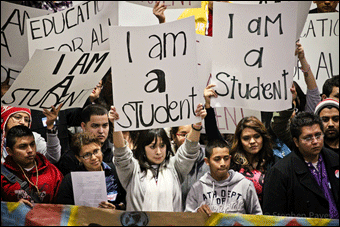 A DOZEN teenagers and twenty-somethings shuffle self-consciously to the front of an expansive auditorium. They scan the 500 eyes staring at them and each take a deep breath.
A DOZEN teenagers and twenty-somethings shuffle self-consciously to the front of an expansive auditorium. They scan the 500 eyes staring at them and each take a deep breath.
Fist cupped to his mouth, one young man gets a beat-box going. At his side, his peers start swaying to the rhythm, before they all join in:
Throw your fists in the air,
And pop ‘em like you just don’t care.
And if you’re down with the DREAM
And you know what I mean
Say…“Oh yeah!”
The chant is exuberant, defiant, and playful. And the crowd of mostly Latino youth embraces the simple rhyme created by these kids from Colorado. When the beat-box dies down, raucous applause fills the Memphis auditorium, before another group from California captures the spirit of the day with their own simple chant: “We exist! We resist!”
On this March weekend, the cavernous hall takes on a youthful air. The handful of older allies are too sheepish to ask the organizers why no one arranged for coffee; singing, dancing, crying, and hugging are a central part of the agenda; and emotion is embraced rather than repressed.
Here in Memphis, representatives of fifty-five youth organizations from twenty-five states have gathered for a national congress for undocumented immigrant youth, organized by the United We Dream (UWD) network. The weekend congress features speakers, break-out sessions, and training events. First, civil rights leader Hollis Watkins speaks to these immigrant youth about lessons they can learn from the civil rights movement, and 250 bodies envelop him in an enormous group hug. Later, teenagers tell their stories to one another—recalling the first time they learned they were undocumented, the moment they realized how that would constrain them from going to college or getting a job, the decision to join a youth struggle, and the bittersweet sensation of having come so far but still coming up short. And, on Saturday night, the group holds a rally to demand the protection of undocumented children’s right to education in Tennessee.
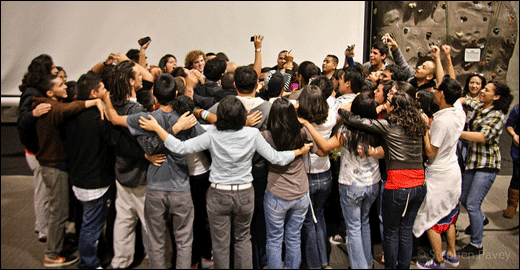
This gathering offers young people an opportunity to channel their stories, aspirations, and anger to continue building a movement to achieve justice for themselves and their families. They have come together to hone their organizing skills, develop relationships with activists from around the country, and sharpen their strategy for the coming year.
In December, these students led efforts to pass the DREAM (Development, Relief, and Education for Alien Minors) Act, which would offer a conditional path to citizenship for undocumented youth raised in this country who attend college or serve in the military. Youth organizing proved critical for DREAM’s passage through the House of Representatives, but the bill ultimately came five votes short of overcoming a Senate filibuster. Since then, the conventional wisdom has been that, in the words of UWD co-founder José Luís Marantes, “the immigrant rights movement is on defense while the anti-immigrant folks are on offense.” But, according to Marantes, DREAM activists refuse to accept that logic: “that sing-song, cyclical thing that’s been happening for the past decade has to be broken.”
These young activists know that the odds of achieving federal legalization for any undocumented immigrants during the next two years are slim, but they refuse to accept defeat. Over the past decade, immigrant youth organizing has gone from a mere afterthought to a formidable, autonomous force. If these students have their way, their strength will only continue to grow.
IN 2002, a little-known piece of legislation called the DREAM Act passed a Senate subcommittee. Pro-immigrant advocates, thrilled at the prospect of legalizing these students’ status, rustled up DREAM-eligible youth (Dreamers) for an immigrant student training and lobbying day on Capitol Hill to show the bill’s human face. According to Josh Bernstein, a UWD Board member and coauthor of the original DREAM legislation, during the lobbying visits the students always had “an immigrant rights organizer next to them. It was very much like they were there to be shown—they didn’t have agency.” Despite the efforts of established advocates and their neophyte companions, the bill failed to make further progress. But a seed had been planted. Bernstein notes, “some of those students are still active today.”
Fast-forward to 2010, and the organizing landscape had changed considerably. National pro-immigrant organizations were still supporting the DREAM Act, but primarily as part of comprehensive immigration reform (CIR) legislation, and youth activists were no longer willing to quietly accept their elders’ instructions. By late spring, many had openly rebelled, demanding that the country’s largest pro-immigrant legislative coalition throw its full weight behind DREAM. With very limited resources and minimal infrastructure, youth organizations established a broad repertoire of contentious action to push the envelope and transform DREAM into a big-ticket item on the congressional agenda. Their movement had arrived.
The ensuing legislative fight for DREAM was the closest thing since 2007 to major pro-immigrant legislation becoming federal law, and it exposed many Americans to the bill for the first time. As the vote neared, pro-immigrant groups took to the streets and Capitol Hill and ratcheted up their media campaign. Meanwhile, restrictionists launched a counter-attack and denounced what they deemed “amnesty.” In the end, the restrictionists won the battle. And while President Obama called for passing DREAM in the 2011 State of the Union address and at a recent speech in El Paso–and thirty-two Senate Democrats have re-introduced the bill–federal legislative progress seems very unlikely in the current Congress.
To many Americans, DREAM’s failure in 2010 was just another instance of congressional gridlock. But this particular legislative contest also marked a grassroots youth movement’s ascendancy. Despite the bill’s death-by-filibuster, the Dreamers have, arguably more than any group since the massive immigrant protests of 2006, reignited the struggle for immigrant rights.
OVER THE last decade, youth organizing for the DREAM Act has gone from a subsidiary operation to a full-fledged movement. Like the bill itself, DREAM youth organizing was incubated by other immigrant rights groups, particularly the National Immigration Law Center (NILC) and, later, the Center for Community Change (CCC). And, as DREAM was introduced in Congress year after year, state and local immigrant organizations kept mobilizing young people.
Eventually, the students began to organize themselves. By the mid-2000s, new immigrant youth organizations began to sprout up. Dreamer Julieta Garibay, for instance, recalls starting an organization in Austin, Texas—the University Leadership Initiative (ULI)—in 2005: “When we started, there was no space for us. It was like, ‘Oh, you guys can come to our conference.’ But we never had our own space where we called the shots. We wanted that space for Dreamers to say, ‘We’re doing our campaigns, and we’re running it.’” Over time, groups like ULI surfaced nationwide, with names like the California Dream Team Alliance, New York State Youth Leadership Council, and Florida’s Students Working for Equal Rights. Student groups began marching, rallying, visiting congressional offices, and reaching out to other Dreamers. Bernstein notes, “More and more, the students were taking responsibility, and rebelling against being marginalized, because they were always seen as a secondary or additional thing within organizations.”
But, when another push for DREAM came up eight votes shy of overcoming a Senate filibuster in 2007, many Dreamers became dejected. No broader network existed to coordinate their efforts, and groups—highly supportive of then-candidate Barack Obama—became preoccupied with electoral organizing. Still, Dreamers continued organizing, and after the 2008 election, youth leaders from around the country convened. Refreshed by the air of progressive optimism that followed the Obama victory, the Dreamers decided to launch a national, Dreamer-led activist network, United We Dream (UWD). Over the next two years, according to Dreamer and Board Member Felipe Matos, UWD helped these youth activists go “from being a scattered group of students all over the United States to being a national network.”
In 2009, UWD joined a slew of other organizations in the Reform Immigration FOR America (RIFA) campaign, the national legislative vehicle supporting CIR. RIFA brought together an enormous array of groups—including established immigrant rights organizations, organized labor, and business organizations—advocating for a CIR bill that would include DREAM among other provisions. The groups under this large tent felt optimistic that President Obama, who had pledged his support for CIR, would deliver.
José Luís Marantes recalls that “at the beginning of 2009, most of the immigrant rights movement was unified around CIR post-Obama’s election. It felt like it was deliverable.” But several factors dimmed the prospects for another major piece of progressive legislation: the economic crisis hit, the health care debate dragged on, the upstart Tea Party gained traction, and Senate Republicans demonstrated unprecedented party unity. In short, pro-immigrant advocates had built a legislative coalition for a CIR fight for which Congress had very little appetite.
With CIR’s star fading, the Dreamers increasingly looked for a stand-alone DREAM Act. But many in the pro-CIR camp did not want to abandon a comprehensive strategy. Marantes describes the Dreamers’ desire to go for a stand-alone DREAM Act, already introduced with forty Senate co-sponsors: “that theory of change clashed with [the notion that] we need to get the biggest amount of reform for the biggest amount of people. And, given that the folks with [the pro-CIR] thought process have larger access to resources, have been much more established—it became the dominant narrative.”
But the Dreamers were undeterred. And, in 2010, they chalked up several victories.
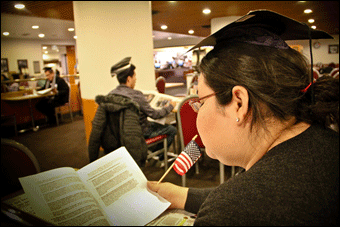 First, their organizing convinced RIFA and its congressional allies to pivot to a DREAM-focused strategy. Youth actions began in January with the Trail of Dreams, in which four Dreamers drew attention to their cause by walking 1,500 miles from Miami to Washington, D.C.—declaring their undocumented status as they traversed many inhospitable areas of the American South. In the following months, Dreamers also led rallies, marches, “study-ins,” and other forms of direct action.
First, their organizing convinced RIFA and its congressional allies to pivot to a DREAM-focused strategy. Youth actions began in January with the Trail of Dreams, in which four Dreamers drew attention to their cause by walking 1,500 miles from Miami to Washington, D.C.—declaring their undocumented status as they traversed many inhospitable areas of the American South. In the following months, Dreamers also led rallies, marches, “study-ins,” and other forms of direct action.
Nor were Dreamers afraid to go to jail. In one prominent case in May 2010, five undocumented young people held a sit-in at Senator McCain’s office—the first instance of Dreamer civil disobedience. As Juan, Communications Director for Dreamactivist.org (an online resource for undocumented youth), explained, “Five students went into the office of John McCain and told him that he had supported the DREAM Act once, and he needed to again.” After refusing to meet with McCain unless he pledged to reverse his position, four students were arrested and three were given deportation orders, which remain pending. These students, organized under the more radical Dream is Coming project, hoped that ongoing escalation would raise the movement’s profile and push the envelope among pro-immigrant groups.
Nowhere was the movement’s escalation more evident than in a series of hunger strikes. For instance, New York Dreamers starved themselves for ten days in July to press Senator Charles Schumer (D-NY) to support stand-alone DREAM legislation. And, in San Antonio, Texas Dreamers refused food for forty-three days in November and December to pressure former DREAM supporter Senator Kay Bailey Hutchison (R-TX) to support the bill.
Despite some internal disagreements about whether and how to use civil disobedience, the Dreamers’ wide repertoire of direct action paid off. After months of debate within the pro-CIR camp over which strategy to pursue, major players within RIFA threw their support behind a stand-alone DREAM bill. On August 5, for instance, the AFL-CIO’s Executive Council issued a resolution supporting DREAM, its first such declaration on immigration since voicing support for CIR in 2009.
By December the DREAM Act had gone from an obscure piece of immigration legislation to a centerpiece of Congress’ “lame-duck” agenda. After an initial Senate vote failed in September, Dreamers and their allies mobilized hundreds of thousands of calls, faxes, and emails to Congress to make sure that DREAM got onto, and remained a part of, the lame-duck docket.
At the same time, immigrant youth activism got the country’s attention. Dreamers developed a compelling iconography to highlight their stories. Graduation caps and gowns became ubiquitous at DREAM events, where students not only protested but also donated blood, prayed alongside religious leaders, and in one case held a “study-in” in a Senate cafeteria. Those Dreamers who wish to serve in the armed forces also played their part, dressing in fatigues and donning flags while they marched and saluted their way through the Capitol. These actions reinforced a persuasive narrative of young people who simply want to study and serve.
This narrative first helped the Dreamers become darlings of Spanish-language media outlets, with extensive coverage of their actions and frequent interviews of their leaders. Juan, a Dreamer from New Mexico, recalls the December Senate vote. “Univisión interrupted its program to allocate time to cover the DREAM Act. Two, three years ago, even within our Latino communities, people wouldn’t know what the DREAM Act was. Now, they know. We’ve put it on the map.” Organizing among Latinos was so successful that, by February 2011, a Latino Decisions poll showed 85 percent of registered Latino voters supporting the DREAM Act, compared to consistent support of roughly 75 percent of Latino registered voters for CIR in prior Latino Decisions polls. And the attention extended beyond Univisión. In advance of the December lame-duck vote, virtually every major English-language U.S. newspaper issued a pro-DREAM editorial.
The Dreamers had seized control of their own movement. According to Julieta Garibay, Dreamers established “our own power, our own voice. It used to be policy analysts telling us, ‘this is how you do it.’ Now, we’ve said, ‘We want to know how to do it.’ We really own what we should be doing.” In Memphis, leaders repeatedly emphasized that they were no longer waiting for others to show them the way. One Dreamer, Carlos, reminded his peers, “Think about all those moments when people said no. For example, us being here—over 200 students—no one thought it was possible. But we made it possible as a movement. This movement is about turning those nos into yeses.”
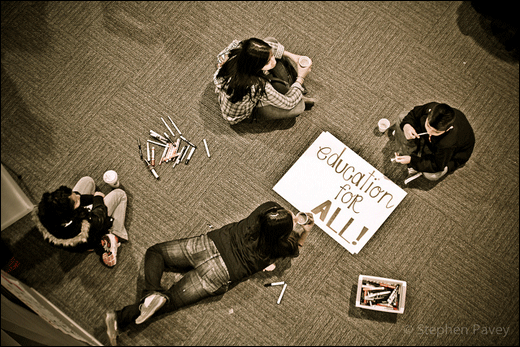
STILL, A loss is a loss. And, facing a tremendously unfriendly political climate on immigration, you might expect another wave of pessimism from Dreamers. Indeed, following the bill’s loss, many Dreamers—whether huddled in the Senate balcony or watching from afar on C-SPAN—wept openly.
But local organizations and national youth leaders responded quickly to quell defeatism and devise new strategies. Juan, the New Mexico Dreamer, remembers, “when it failed on Saturday, December 18, I was disappointed, angry…But we were able to channel those energies into these efforts. It really challenged and motivated us to move on.”
In Memphis, UWD’s focus is on consolidating the past year’s gains. Activists hone in on three things: story, structure, and strategy.
The first point draws on Harvard professor Marshall Ganz’s work on “public narrative”—communicating “a story of self,” “a story of us,” and “a story of now.” Public narrative begins with using one’s story to connect to a broader collective and to motivate others to act.
Dreamers have no shortage of compelling stories. Take Amber, a Dreamer who came to this country at age three, who recalls the first time she learned she was undocumented: “My parents explained that that’s why we couldn’t go to Disneyworld. At nine years old, I imagined Mickey Mouse asking me for my papers. At nine years old, I understood that my parents could be taken away. Whenever my parents were late to pick me up, I was afraid that they’d been taken away.”
Stories like Amber’s have made Dreamers arguably the most sympathetic group of undocumented immigrants to the American public; a December Gallup poll showed majority support for DREAM. The movement’s challenge now is to scale up these stories to mobilize further collective action that could help change the public conversation from blanket denunciations of “amnesty” to consideration of immigrants’ motives for migrating and their economic potential and contributions.
On structure, the Dreamers are seeking to strengthen a national network that can better coordinate action and develop strategy. Although the movement has demonstrated a capacity for persistent and contentious collective action, UWD’s national coordinator Carlos Saavedra acknowledges, “We didn’t build an organization that was strong enough, because we were always in campaign mode. We didn’t take enough time to step back.” UWD’s Memphis congress is one step to address this problem. The network’s leaders seek to provide activists with tools to strengthen their own organizations—by learning things like nonprofit governance and online activism strategies—and opportunities to discuss and come together around the network’s political goals.
On strategy, UWD and its allies are focused on three things: defending against anti-immigrant state legislation, promoting in-state tuition legislation in immigrant-friendly states, and pressuring the Obama administration to end deportations of undocumented youth who grew up in this country.
This year, at least two dozen states have considered laws modeled on Arizona’s SB 1070, officials from fourteen states have pledged to try to repeal birthright citizenship in their states, and others are working to curtail public services to undocumented immigrants. As Julieta Garibay explained, “Right now, in our field calls, it feels like everyone’s getting hit left and right. You’re either getting banned from college or you’re getting criminalized.” Dreamers nationwide have joined the broader efforts to fight anti-immigrant legislation, calling particular attention to provisions that would affect young people—such as Governor Susana Martínez’s effort to strip all undocumented people of driver’s licenses in New Mexico (one of two states to offer licenses to the undocumented).
Dreamers are also launching an offensive strategy in more immigrant-friendly states to gain access to in-state tuition, financial aid, and/or work authorization. In New York, for instance, State Senator Bill Perkins introduced a state-level DREAM Act that would provide Dreamers with access to state financial aid, identification, eligibility for state health insurance programs, and work authorization. Cesar, a Dreamer from New York, notes, “This is a bill that says that we refuse to take a defensive approach.”
The third piece of Dreamers’ medium-term strategy is the Education Not Deportation (END) campaign. Through END, Dreamers will fight individual deportation cases to, in Felipe Matos’ words, “unveil the moral crisis caused by the current enforcement, detention, and deportation policies.” President Obama and Department of Homeland Security Secretary Janet Napolitano have stated that, while they support DREAM and Dreamers are not a priority for deportation, they have to enforce existing laws. As deportations mount, Dreamers hope to use direct action and further media attention to increase their communities’ ire and force Obama to explore policy alternatives. In April, twenty-two Democratic senators (including party leaders Harry Reid of Nevada and Dick Durbin of Illinois) signed a letter to the president requesting such administrative relief.
MOVING FORWARD, the Dreamers hope to continue expanding their movement and escalating contentious action. The movement’s capacity will likely revolve around its ability to build new alliances and consolidate existing partnerships.
The first potential partners are other pro-immigrant organizations. Nationally, groups under the RIFA tent—such as the National Immigration Forum, CCC, America’s Voice, SEIU, and AFL-CIO—have strongly advocated DREAM’s passage and supported youth activism. But some Dreamers perceived RIFA’s support for a stand-alone bill as too little too late. Currently, UWD remains a part of RIFA’s management team, but leaders express ambivalence about the relationship. José Luís Marantes expressed the tension this way:
We don’t believe in burning any bridge. But we also know that our movement requires vision and leadership, and that leadership won’t come from seniority or years of experience—it comes from inspiration. And that inspiration comes from a lot of young people that are at this conference right now…[O]ur dream is to be the point of the spear…to open the political space so that we can actually have conversations about comprehensive immigration reform or other forms of reform to get there.
UWD’s leaders also recognize that they are not the entire DREAM movement. After the December failure, some youth groups expressed dissatisfaction with certain UWD tactical decisions and formed a splinter coalition, the National Immigrant Youth Alliance (NIYA).
Such division was, perhaps, predictable; blame often closely follows defeat. And, to some Dreamers, the split need not damage the movement. Carlos Saavedra, for instance, indicated that the networks have “the same vision, but different strategies,” a sentiment that Juan from Dreamactivist.org and NIYA echoed, saying that it’s “a difference—not in agenda…but in direction.” But, in politics, unity brings power. Facing a climate filled with anti-immigrant hostility, Dreamers need to assiduously avoid undermining one another’s efforts.
Already, DREAM enjoys near-unanimous support among Latino immigrants and non-immigrants. The bill has also received strong backing from Asian-American organizations, such as the National Korean American Service & Education Consortium (NAKASEC) and the Asian American Justice Center (AAJC). According to AAJC Executive Director Karen Narasaki, ten percent of DREAM-eligible students are Asian-Americans. A USC/LA Times poll in November 2010 found that over 70 percent of Asian registered voters in California supported the bill.
But Dreamers will also need to negotiate alliances with non-immigrant allies. This can lead to a tension between building power by closing ranks—reminiscent of the transition to Black Power in the late 1960s in organizations like SNCC—and drawing value from other supporters. As Julieta Garibay explains, “we really want to own it, but we also know that we can’t do it by ourselves.”
Who beyond immigrant youth—or even established immigrant-rights groups—might be worth courting? Representatives of several allied organizations—the AFL-CIO, NILC, and various UWD funders—are present in Memphis. But Dreamers, both at the local and national levels, need to continue to pull in faith leaders and organizations. Already, they have spoken to congregations and organized “pray-ins” with religious leaders. In December 2010, for instance, faith leaders and Dreamers joined forces for a rally hosted by the United Methodist Church, followed by a “Jericho March” through the capital to pressure legislators. Strong DREAM supporters in the faith community—virtually all of whom began supporting DREAM as part of CIR—include the Methodists, the United Conference of Catholic Bishops, the Hebrew Immigrant Aid Society, and the Unitarian Universalist Association of Congregations. The Dreamers must consolidate and expand faith group alliances—particularly among Evangelical groups—that offer a means to build a broader support base for their efforts.
Religious leaders could also provide a link to the African-American community. Recently, restrictionists like Representative Lamar Smith (R-TX) have sought to pit “black against brown” by arguing that Latino immigration negatively affects African Americans. But current anti-immigrant legislation has opened the door for racial profiling, and proposed Republican cuts to social services will affect both immigrants and African Americans. Such legislation may, then, create common ground, especially given the African-American community’s strong history of civil rights activism. Already, the NAACP and the Leadership Conference for Civil Rights have publicly backed DREAM. Moreover, UWD got the support of Alpha Phi Alpha (APA)—the nation’s oldest Greek-letter African-American fraternity, whose past members include Martin Luther King and Thurgood Marshall—to push back against the deportation of an undocumented APA member, Mario Pérez.
But there is still much work to be done in engaging the African-American community. Pew Research Center polls from June 2010 and February 2011 suggest that roughly 70 percent of African Americans support offering citizenship to undocumented people or coupling legalization with enhanced border security. But the same Pew polls showed African Americans to be even more concerned than whites about the impact of illegal immigration on U.S. jobs. Similarly, a February 2010 Pew poll showed African Americans split evenly on whether immigrants were a burden (44 percent) or boon (43 percent) to the country. These polling figures suggest significant opportunities for Dreamers and their pro-immigrant allies to expand alliances, but also prevailing ambivalence within the African-American community that Dreamers and their allies must work to overcome.
The final key potential ally may also prove the most controversial: LGBTQ groups. UWD has displayed a strong pro-gay rights orientation. Several UWD leaders introduced themselves to the congress as “queer, undocumented, and unafraid” before making a presentation on their experience of dual exclusion—being dismissed as “illegals” and denounced as maricones (the Spanish equivalent of “faggots”). Dreamers seem to have a natural affinity with the queer community: both groups share the experience of having concealed a central piece of their identity to protect themselves. Both groups also know what it means to “come out”—Dreamers have increasingly revealed their undocumented status, abandoning previous precautions like turning away from the camera and not using their names during their organizations’ actions. In a telling show of hands in Memphis, many more Dreamers reported ties with queer groups than with African-American organizations. One Dreamer, shaking off trembles and tears, came out for the first time as queer to the UWD congress, before finding himself at the center of an enormous group hug.
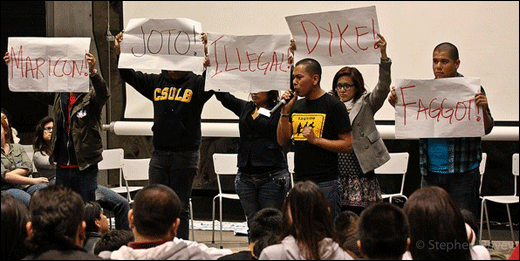
Politically, the risk of the LBGTQ alliance would be alienating certain potential Latino and African-American partners—particularly socially conservative religious leaders. Carlos Saavedra explains, however, that UWD leaders refuse to concede their ideals: “in the intermediate term, there will be some reaction. But that’s essentially what we want…Part of our work is to change our own [Latino] community, even if it takes power from us at this point.”
Many progressives would surely applaud such a principled stand. But potential progressive allies have at times taken umbrage with another piece of the DREAM debate: the bill’s military provision. The military provision delivers the practical benefit of offering Dreamers an additional avenue to legalization and higher education. It also provides the political boost of enabling DREAM supporters to frame the bill in terms of national security (the military option enabled Democrats to introduce DREAM as an add-on to defense legislation). But some progressives fear that, given the difficulties and expense of getting into college, Dreamers might have to choose military service to become citizens, fueling concerns about young minorities disproportionately being forced to fight the country’s wars.
The Dreamers reject these concerns as both overstated and paternalistic. According to a report by the nonpartisan Migration Policy Institute, relatively few Dreamers—approximately 30,000 of the two million eligible youths—would likely end up in the military. Even if large numbers of Dreamers wanted to serve in the military, many would struggle to meet acceptance requirements—particularly those with a GED (whom the military rarely accepts) and those with weak English skills (the military requires passing an aptitude test in English).
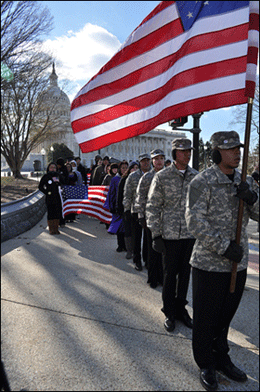
Moreover, virtually none of the opposition to the military path comes from Dreamers themselves, who have repeatedly expressed frustration with older allies making pronouncements about their “best interests.” As José Luís Marantes notes, the Dreamers are focused on “maximizing education options—not about forcing people down that [military] path.” Would they also like the community service provision, an option offered by an earlier version of the legislation? Yes. Would they oppose the military service provision if it were obligatory? Unquestionably. But, as the bill stands, Dreamers appear united in respecting the desire of some of their peers to serve in the military.
LOOKING AT this country’s broader political landscape, the Dreamers are one of only a handful of bright spots for pro-immigrant advocates amid a climate of marked anti-immigrant hostility. In some ways, such activism defies the odds: Dreamers are young, have relatively few material resources, and lack the legal protections afforded to citizens. Considering the age issue, Josh Bernstein notes: “Historically, youth organizing has been very episodic, and then those leaders and that generation goes on. The DREAM Act is different because the Dreamers are stuck. It’s bad for them, but it’s actually good for organizing. You have people here who’ve been involved since 2004, 2005, 2006.”
This relative longevity has contributed to the creation of Dreamer organizations across the country. As time has gone on, these students have become increasingly defiant, developing innovative and daring grassroots organizing and protest tactics. Looking forward, in an inhospitable political environment, Dreamers will need to continue to draw on their courage and creativity to pry open a window for national legislation to protect them and their families.
What such an opening would look like is hard to predict. By late 2010, virtually the entire pro-immigrant community had come around to supporting a DREAM stand-alone bill. Since then, the strategy of pro-immigrant activists, whether young or old, has centered on fighting back against anti-immigrant state legislation and pressing the executive branch to reform enforcement practices. Should pro-immigrant activists succeed in building momentum to change the tenor of the nation’s immigration conversation, the debate between comprehensive and piecemeal approaches could well resurface. Dreamers, who want legalization for their entire families and communities, are supportive of a comprehensive solution—if it is feasible. As one young activist, Efraín, said of a solution that would also offer legalization to undocumented farmworkers, “the farmworkers are also our parents, our uncles, our cousins. We are all equally deserving.” But the Dreamers are also eager to capitalize on every inch of space that opens for legislation that would benefit them. Until they escape the shadow of deportation and eliminate the barriers that keep most of them from higher education and employment, the Dreamers will continue to center their activism on youth-focused legislation.
While the Dreamers continue to fight, they also know how far they have come. Bernstein reflects: “The only thing I can compare it to is SNCC. It’s the same thing…young people being the ones to take the reins and be courageous on behalf of what’s right, without being limited to a narrow vision of what they want to accomplish. The young people at SNCC changed the world. And I feel that these young people at United We Dream are in that category.”
Daniel Altschuler is a Copeland Fellow at Amherst College and a doctoral candidate at the University of Oxford, where he studied as a Rhodes Scholar. He has written extensively on immigration politics, including recent pieces for the Christian Science Monitor, Americas Quarterly, the Nation, and CNN.com.
All photos courtesy of Steve Pavey






